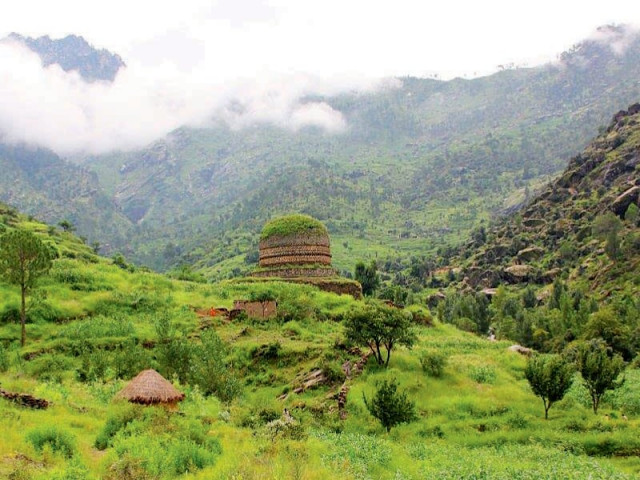World Tourism Day: Archaeological heritage remains vulnerable in Swat due to govt disinterest
Locals complain vital road links in disrepair; tourism industry struggles after TTP insurgency

Locals say God has been generous with his blessings in the Swat Valley. Known as the Switzerland of Asia, the valley is home to snow-capped mountains, roaring waterfalls, lush forests of cedar trees, abundant fruit orchards and crystal clear lakes as well as the Swat River.
It is no wonder that tourism is the valley’s backbone and more than 60 per cent of the local population is directly or indirectly connected with the industry. However, these people do not say they are helping tourists – they believe they are helping ‘guests’, an indicator of their welcoming nature.
Between 1988 and 2004, tourism thrived here. According to the All Swat Hotel Association, 500 hotels mushroomed in the valley during this period as well as 600 restaurants, all catering to the valley’s ‘guests’.
Swat Valley is believed to be the site of the Uddiyana Kingdom (the sacred land of ancient Buddhism), where Padmasambhava (Lotus-Born) or the ‘Second Buddha’ is believed to have been born. Padmasmabhava is known to have transmitted Vajryana Buddhism in the 8th century to Tibet, Bhutan and other neighbouring countries.
Apart from hosting the second largest rock carved sculpture of Lord Buddha, the Bazira (citadel or fort) of Alexander the Great, and the 11th century mosque of Mahmud Ghaznavi, one can find numerous ancient archaeological sites in Swat by following a maze of passages amid lush green meadows, rocky ascents, medicinal springs, trickles and streams, wild berries and fruit trees.
“This is one of the first areas of the Hindukush-Kakakoram-Himalaya to show human presence in Paleolithic times,” explains Dr. Luca Maria Olivieri, an Italian archaeologist who has spent 27 years studying Swat. “It was one of the first places where the domestication of rice was introduced from China in Neolithic times. As a strategic bulwark for Achaemenians, Mauryans, Indo-Greeks, Parthians, and Hindu Shahi during the Kushan Empire, Swat became one of the most important Buddhist regions,” he elaborates. Olivieri says the heritage in Swat is ‘almost intact’, which ranks it among the top 50 most important archaeological areas in the world.
However, despite the valley’s historic foundations, tourists and scholars say the Pakistani government’s lack of interest means the cultural and archaeological heritage here is not being protected.
“If nothing is done the sites will disappear either by natural causes or by willful destruction by those who consider them a remnant of a past, idolatrous culture,” says Shehla Anjum, who has been a visitor to Swat since the 1970s.
Anjum compares the Balo Kaley, Amluk Dara stupa, Shingardar stupa, Butkara, Najigram and Bazira to sites such as Cambodia’s Angkor Wat or complexes of temples in Thailand and Cambodia. “With careful planning, these could be world-class destinations for tourists,” she says.
“We need better access to the area, basic facilities at the sites, such as restrooms, and most importantly, the people must take ownership and pride in the remnants of Buddhist culture here. The heritage and culture of Gandhara is theirs. It defines them, and its influences are still evident in the architecture, arts, and handicrafts created today,” she adds.
Tourism here took a hit in 2007, when Mullah Fazlullah challenged the writ of the government and began preaching his own version of Sharia law via an FM radio station. “During the Taliban insurgency in Swat, those employed by the tourism industry were left jobless,” says Abdul Ali, a hotel owner.
Then in 2010, the floods washed away an estimated 128 hotels and destroyed infrastructure. Nearly 43 bridges were swept away and 663 kilometers of road ruined.
“The government did not help us as we expected it to,” says Amjad Ali, a local activist. “The most important sector to maintain the tourism industry – the road links to Swat – were destroyed.” He jokes that the 45 kilometer road from Bahrain to Kalam is now only fit for ‘adventure seekers’.
A grant of Rs2.5 billion from the Asian Development Bank was allocated for the reconstruction of the Kalam Road, but the road continues to be unusable.
Meanwhile, an injection of Rs6.5 billion from the Saudi government was set aside to fix the Chakdara-Bahrain road, which has almost been completed.
However, while local business owners say the lack of safe access to the Valley has cut off their livelihood, Deputy Commissioner Swat Mahmood Aslam Wazir insists tourism has begun to thrive once more in Swat. “In this season alone, 600,000 tourists visited the valley,” he says. “That’s a record turnout and indicates that people feel confident returning here.”
Published in The Express Tribune, September 27th, 2014.













COMMENTS
Comments are moderated and generally will be posted if they are on-topic and not abusive.
For more information, please see our Comments FAQ